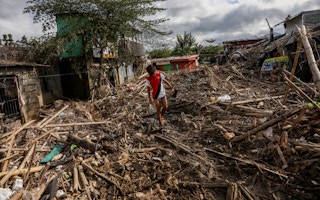The Philippine government submitted to the United Nations (UN) its target to reduce harmful greenhouse gases by 75 per cent by 2030.
To continue reading, subscribe to Eco‑Business.
There's something for everyone. We offer a range of subscription plans.
- Access our stories and receive our Insights Weekly newsletter with the free EB Member plan.
- Unlock unlimited access to our content and archive with EB Circle.
- Publish your content with EB Premium.
The target, known as the “nationally determined contribution” (NDC), was submitted to the UN Framework Convention on Climate Change on Thursday (15 April) according to its website.
The Southeast Asian nation is aiming to cut its greenhouse gas emissions from energy, transport, waste, forestry and industry sectors by 75 per cent from 2020 to 2030, relative to the business-as-usual scenario in the same period.
But 72.29 per cent of the target is conditional, and will only be met through funding and assistance from the international community. The government has pledged to use its own resources to meet the remaining 2.71 per cent.
“
Despite strong calls from the public and environmental groups, the government barely made changes from the target emissions reduction by 2030.
Khevin Yu, campaigner, Greenpeace
Activists lauded the submission but lamented the “disappointing” increase in the unconditional percentage from its original target of 2 per cent in 2015.
“Despite strong calls from the public and environmental groups, the government barely made changes from the target emissions reduction by 2030,” said Khevin Yu, campaigner of watchdog Greenpeace.
“The NDC is supposed to serve as the framework that should set the direction for green policymaking grounded on climate justice, as we face the climate crisis. With unambitious plans for carbon-intensive sectors, the commitment does not reflect the urgency needed to address the climate emergency.”
Rex Barrer, climate governance lead of non-profit Institute for Climate and Sustainable Cities, said that although the government’s low contribution was “frustrating”, he was hopeful of the department of energy’s commitment to improve on the Philippine’s energy plan. The country declared a moratorium on coal in October in a significant shift to boost the deployment of renewables.
The Philippines is highly vulnerable to the impacts of climate change and has seen an increased frequency of extreme weather events. Typhoon Vamco and back-to-back cyclones hit the main island of Luzon in a span of three weeks in November, triggering the worst flooding in the region in 45 years.
United States-based green group The Climate Reality Project asked the Climate Change Commission for a roadmap with “detailed plans and timetables” to peak emissions by 2030.
The Philippines was supposed to have submitted its NDC to the UN by the end of 2020, but was unable to do so after the Climate Change Commission faced harsh criticism for initially planning to reduce its commitment to lower carbon emissions under the Paris climate agreement.
The commission, whose officials also represent the Philippines at the UNFCCC’s annual conference of parties (COP), said that the nation was aiming to reduce harmful greenhouse gases by 30 per cent by 2040—a retreat from its original pledge in 2015 of 70 per cent.
The Paris Agreement decision in 2015 requested parties to communicate every five years either a new NDC, or an update on their existing one, depending on the respective NDC timeframe. Parties decided that their NDCs would reflect each country’s highest possible ambition, and new NDCs would have to represent a progression from the previous ones.
The Philippines is one of the last countries to submit its first NDC. As of 16 April, 192 out of 196 parties have submitted while eight have given their second NDCs.








